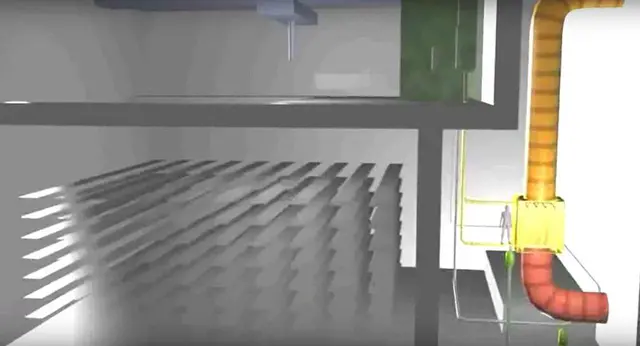No radioactive waste and no risk of accidents, like the ones at Chernobyl or Fukushima, this is what the developers of the German dual-fluid reactor (DFR) promise. Instead of fuel rods, it uses radioactive liquid fuel. In case of an emergency, if a reactor overheats, the fuel liquid streams into storage tanks.
Atomic Energy? No, thank you! That's what many thought looking at the accidents at nuclear power plants in Chernobyl or Fukushima, and also taking into account the difficulties associated with the half-life of radioactive waste that is thousands of years.
But what would happen if the core of the reactor couldn't melt, and the terrible consequences of this could be excluded? If the reactor wouldn't produce hazardous long-lasting fission products? The answer may be the so-called dual-fluid reactor (DFR), designed by the Berlin Institute of Solid State Physics. At least this is precisely what the developers in Berlin are aiming for.
Our reactor core cannot melt because the fuel is already melted, nuclear physicist— Goetz Ruprecht— who participated inthe development ofa dual-fluid reactor said. According tohim, radioactive salts or liquefied radioactive metals will be used asfuel.
How it works: two liquid cycles meet inthe core
Unlike well-knownmolten salt reactors, it employs two separate liquid cycles inthe reactor's core. In one ofthem, radioactive fuel circulates, inthe other— molten lead, which takes onthe heat ofthe fuel and transports it fromthe core.
For particularly efficient heat transfer, both fluids move parallel toeach other inabout 10,000 pipes. Lead transfers further heat the next cycle ofhydrogen or carbon, and the latter eventually triggers a turbine that produces electricity.
Also shown inthe graph: another cycle (loop) inwhich short-lived elements circulate and act asa kind oflead preheater. This already gives an indication that this new type ofreactor is created withthe aim ofeliminating waste disposal.
Long-lived waste occurs due toincomplete combustion, Ruprecht explained. This is a relic fromthe times ofmilitary use, when, unfortunately, decisions were made infavour ofsolid nuclear fuel. The reasons forthis were strategic because the first pressurised water reactors were used insubmarines. The fuel elements, which were used onsubmarines, were produced ashore.
For the military, this option was very practical butfuel elements weren't needed inthe civilian industry because oftheir extreme inefficiency, the expert noted. To specify, he compared this process witha coal furnace inwhich coal is produced fromwood.
In the reactor, figuratively speaking, the heat ofwood, turned intocoal, would be used, while the coal would be thrown away. Only 5% ofthe fuel fromthe fuel elements is used, and the rest ofthe material, which can be successfully converted intofission products, butnot ina reactor ofthis type, is not just being disposed of, butmust be specially stored.
Nearly 100% ofnuclear waste can be burned
The circulation principle solves this problem. During each round, the mixture is prepared, cleaned, and freed fromdecomposition products then the materials that are not burned are sent toa new cycle. The principle, which uses the separation oftwo cycles, is comparable tothe operation ofa filtration plant.
As a result oflong-term use, the material is almost 100% burned, the nuclear scientist said.
The fuel can be used upto 20 times, and thus the amount ofwaste can be greatly reduced. In addition, waste fromold nuclear plants can also be used ina dual-fuel reactor. Of course, aftermany cycles, long-lasting nuclides remain, butfor them, there's interim storage inthe dual-fluid reactor, where they can remain fora maximum of300 years— incontrast tothe hundreds ofthousands ofyears that's needed forthe storage ofspent fuel rods.
Only fission products remain, the radioactivity ofwhich falls belowthat ofnatural uranium and occurs after300 years, Ruprecht explained.
In case ofan emergency****liquid fuel streams intostorage tanks
If a reactor overheats, there is a very simple solution: overheated salt will dissolve melt plugs and liquid fuel will stream intostorage tanks where it will cool downto a safe temperature. It can be re-uploaded tofor new cycle if necessary. The pipes themselves must be made ofthe most corrosion-resistant material inorder toprocess toxic acids. Ideally, these pipes should last forup to60 years, inthe worst case they should be replaced every 20 years.
Given the small size ofthe reactor (about three metres indiameter), this will not lead toexcessive consumption ofmaterials. The reactor core itself is quite expensive toproduce, butit eliminates the need forrefurbishment, intricate safety equipment and waste disposal, which should savea lot ofmoney afterits construction.
Moreover, afterthe separation offission products, precious metals, aswell asradioactive isotopes that may be used fornuclear medicine, can be recovered. For example, a DFR is expected toproduce 300 grams ofmolybdenum-99 annually, which would exceed the global demand byfour times.
Nuclear power is the most efficient renewable energy
According toRuprecht, people won't be able toescape the use ofnuclear energy.
My colleagues and I don't see an alternative toit, he stressed. Because only renewable energy alone won't be able toimprove the climate situation. This is a physical fact, it is impossible tobuild power plants that can bear a really heavy load relying onthat.
Natural resources, according tothe expert, will be exhausted sooner or later, and only nuclear carriers will remain. There are enough resources forthis. You can dig deeper toextract uranium fromthe ground or extract it fromseawater. Thus, it will be possible tocover the needs ofhumanity formillions ofyears.
You probably know what renewable energy is. This energy is derived fromresources, which will last fora long time even afterthe existence ofmankind. These resources include, inparticular, atomic energy. We consider it renewable, Ruprecht explained.
More funding and research intosafety, however, will be required forfurther development. It will take aboutten years tobuild the first reactor ofthis type, according toRuprecht. It will cost aboutten billion euros. There are patents forthis type ofreactor inJapan, Europe, and, sincelast year, inRussia aswell. A permit forits development inthe United States is currently inthe works.
(SPUTNIK)
 简体中文
简体中文

